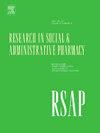减少苯二氮卓类药物过度使用的多学科干预的长期有效性:一项集群对照试验。
IF 3.7
3区 医学
Q1 PUBLIC, ENVIRONMENTAL & OCCUPATIONAL HEALTH
Research in Social & Administrative Pharmacy
Pub Date : 2025-03-22
DOI:10.1016/j.sapharm.2025.03.063
引用次数: 0
摘要
背景:苯二氮卓类药物(BZD)的过度使用已成为一个令人关注的领域,因为它对患者的健康和医疗保健费用的后果。目的:确定与常规治疗相比,基于多学科教育计划的多组分干预是否对BZD长期使用的戒断有效。方法:以健康中心为随机化单位,以患者为分析单位的整群随机、平行组试验。纳入标准:使用BZD超过4周的成年人,无严重精神障碍,非终末期,无酒精依赖或痴呆。干预:(i)与患者讨论BZD使用的优点,缺点和替代方案,并附有教育材料的逐渐减少方案,(ii)提供简短的咨询,(iii)由6个科学协会支持的致患者的信。主要结果是BZD的分配。与BZD消费相关的社会经济变量和其他变量(指征,先前试图停止使用和持续时间)。分析:利用logistic回归的多变量广义估计方程(GEE)扩展分析了干预对BZD配药率的影响。结果:干预6个月后,333名参与者中有108人(32.4%)完全停止配药BZD,而139名对照组中有27人(19.4%)。这种下降持续了5年(41.7% vs. 33.8%)。调整后的绝对风险差为-14.3(-19.6至-9.5)。调整后OR为2.11 (95% CI, 1.24-3.59)。与低收入者相比,高收入者更有可能在干预后停止使用BZD (OR 1.81, IC 95% 1.13-2.9, p = 0.012)。同样地,那些先前试图从BZD中退出的人更有可能在干预后停止使用(OR 1.8, IC 95% 1.17-2.8, p = 0.007)。与低收入者相比,高收入者更有可能在干预后停止使用BZD (OR 1.81, IC 95% 1.13-2.9, p = 0.012)。同样地,那些先前试图从BZD中退出的人更有可能在干预后停止使用(OR 1.8, IC 95% 1.17-2.8, p = 0.007)。结论:干预6个月有效,效果持续5年。有利于中断BZD的因素似乎是有高收入和以前试图退出BZD。本文章由计算机程序翻译,如有差异,请以英文原文为准。
Effectiveness at long-term of a multidisciplinary intervention in the reduction of overuse of benzodiazepine prescriptions: A cluster controlled trial
Background
The overuse of Benzodiazepines (BZD) has become an area of concern because of its consequences on patients' health and healthcare costs.
Objective: to determine whether a multicomponent intervention based on a multidisciplinary education program is effective in withdrawal from BZD long-term use, compared to usual care.
Methods
Cluster-randomized, parallel-group trial with health centres as units of randomization and patients as units of analysis. Inclusion criteria: adults with more than 4 weeks of BZD use, without serious mental disorder, non-terminal, without alcohol dependence or dementia. Intervention: (i) discussion with the patient describing the advantages, disadvantages and alternatives of BZD use accompanied by tapering protocol with educational material, (ii) the offer of a brief consultation, and (iii) a letter addressed to the patient supported by 6 scientific societies. The primary outcome was dispensing of BZD. Socioeconomic variables and others related with the consumption of BZD (Indication, previously attempted to cease and duration of use). Analysis: The effect of the intervention on the rate of dispensing of BZD using the multivariable generalized-estimating-equations (GEE) extension of logistic regression.
Results
Complete cessation of dispensing BZD at six months after the intervention was achieved in 108 of 333 participants (32,4 %) compared to 27 of 139 controls (19,4 %). This decrease was maintained over 5 years (41,7 % vs. 33,8 %). Adjusted absolute risk difference was −14.3 (−19.6 to −9.5). An adjusted OR 2.11 (95 % CI, 1.24–3.59). Those with high income were more likely to quit using BZD with the intervention as those with a lower income (OR 1.81, IC 95 % 1.13–2.9, p = 0.012). Similarly, those who had previously tried to withdraw from BZD were more likely to stop using with the intervention (OR 1.8, IC 95 % 1.17–2.8, p = 0.007). Those with high income were more likely to quit using BZD with the intervention as those with a lower income (OR 1.81, IC 95 % 1.13–2.9, p = 0.012). Similarly, those who had previously tried to withdraw from BZD were more likely to stop using with the intervention (OR 1.8, IC 95 % 1.17–2.8, p = 0.007).
Conclusions
The intervention was effective at 6 months and its effects persist up to 5 years. The factors favouring interruption BZD seem to be having a high income and a previously tried to withdraw from BZD.
求助全文
通过发布文献求助,成功后即可免费获取论文全文。
去求助
来源期刊

Research in Social & Administrative Pharmacy
PUBLIC, ENVIRONMENTAL & OCCUPATIONAL HEALTH-
CiteScore
7.20
自引率
10.30%
发文量
225
审稿时长
47 days
期刊介绍:
Research in Social and Administrative Pharmacy (RSAP) is a quarterly publication featuring original scientific reports and comprehensive review articles in the social and administrative pharmaceutical sciences. Topics of interest include outcomes evaluation of products, programs, or services; pharmacoepidemiology; medication adherence; direct-to-consumer advertising of prescription medications; disease state management; health systems reform; drug marketing; medication distribution systems such as e-prescribing; web-based pharmaceutical/medical services; drug commerce and re-importation; and health professions workforce issues.
 求助内容:
求助内容: 应助结果提醒方式:
应助结果提醒方式:


